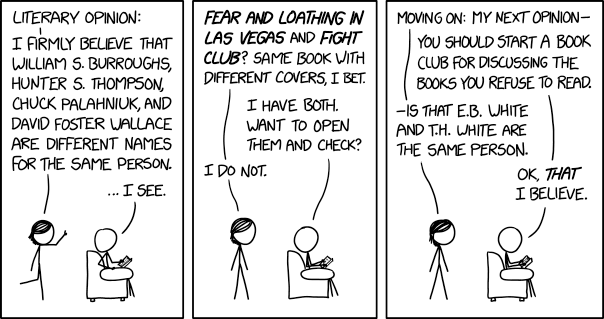Literary Opinions

If I really focus, I can distinguish between John Steinbeck and John Updike, or between Gore Vidal and Vidal Sassoon, but not both at once.

If I really focus, I can distinguish between John Steinbeck and John Updike, or between Gore Vidal and Vidal Sassoon, but not both at once.
Megan is telling Cueball about some of her literary opinions: She believes that William S. Burroughs, Hunter S. Thompson, Chuck Palahniuk, and David Foster Wallace are different names for the same person. Many authors write under pen names for some of their works, or even several different pen names. Sometimes people come to believe that different people are actually a same person, which is known as the Fregoli delusion; the person is usually believed to change appearance.
She then says that Fear and Loathing in Las Vegas (by Thompson) and Fight Club (by Palahniuk) are the same book with different covers, probably because the title and promotional images for both hint at fighting taking place in a big city (i.e., she is literally judging the books by their covers), when in reality the books are vastly different. Books sometimes have different covers and titles in different regions. That said, Fight Club does contain a plot twist where two "different" things turn out to be the same thing (see 109: Spoiler Alert for more information).
Cueball's attempt at a reality check (proposing to actually open the books she is talking about) is met with disinterest. It becomes clear that Megan just wants to share her weird beliefs and does not care if they can be proven false - a theme that previously appeared in 1717: Pyramid Honey.
As a last resort, Cueball humorously proposes she should start a book club to discuss the books she has not read. This may be to congregate all people who criticize books without reading them, or in hopes that it will be attended by people who have read the book and can prove to Megan her opinions are baseless.
Megan finishes telling him her opinion anyway, which is that E.B. White and T.H. White are the same person. This is apparently an opinion that Cueball can agree with, as he tells her that he believes it. This is likely a joke that the two names are hard to distinguish due to the having the same last name with only initials instead of a first name. In reality, the books they authored are very different, with E.B. White writing children's books (Charlotte's Web, Stuart Little, etc.) and T.H. White writing adult books about King Arthur (The Sword in the Stone and its sequels), although his works were adapted into a Disney movie so they could, to some degree, be considered children's books.
The title text continues with this, with Megan saying that she can distinguish between John Steinbeck and John Updike, or between Gore Vidal and Vidal Sassoon, but she can't do so simultaneously. Again this is likely due to the similarities in their names. However, John Steinbeck and John Updike are also easy to confuse because they are both giants of 20th century American literature, whereas Gore Vidal has almost nothing in common with Vidal Sassoon (see chart below).
Additionally, the mention of simultaneity could be a nod to the Heisenberg uncertainty principle, which states that there is a trade-off in precision when simultaneously measuring position and momentum. It could also be a nod to how the brain cannot simultaneously interpret two different things at once, similar to looking at the Rabbit-duck illusion; at any moment, one can only see a duck or a rabbit in the image, but not both at exactly the same time.
Explanation of people mentioned
Name Description William S. Burroughs (1914–1997), American writer and visual artist. Wrote many semi-autobiographical works, best known for Naked Lunch and Junkie. Hunter S. Thompson (1937–2005), American journalist and author. Founder of the Gonzo journalism movement. Best known for his novel Fear and Loathing in Las Vegas. Chuck Palahniuk Born 1962, American novelist and freelance journalist from Pasco, Washington. Best known for his novel Fight Club. David Foster Wallace (1962–2008), American writer and university professor for English and creative writing. Best known for his novel Infinite Jest. E.B. White (1899–1985), American writer. Co-author of the English language style guide The Elements of Style. Also known for his children's books, including Stuart Little, Charlotte's Web, and The Trumpet of the Swan. T.H. White (1906–1964), English author. Known for his Arthurian novel series, The Once and Future King. John Steinbeck (1902–1968), American novelist. Known for his novels set in Central California, including Tortilla Flat, Cannery Row, East of Eden, Of Mice and Men, and The Grapes of Wrath. John Updike (1932–2009), American novelist, poet, short-story writer, art critic, and literary critic. Known for his prolific career and for his "Rabbit" series, chronicling the life of Rabbit Angstrom. Gore Vidal (1925–2012), American writer and public intellectual. A political commentator and essayist, as well as a novelist. Vidal Sassoon (1928–2012), British-American hairstylist, businessman, and fashion icon. Founded a worldwide chain of hairstyling salons as well as a line of hair treatment products. A philanthropist later in life.